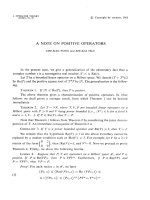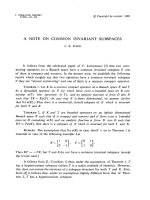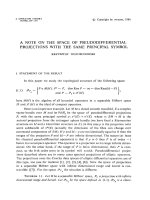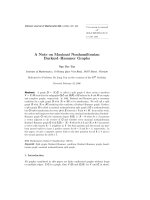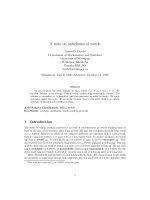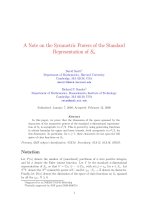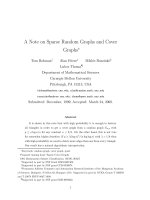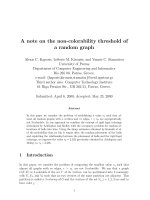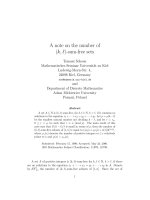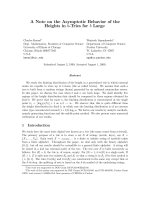Báo cáo toán học: "A note on K∆+1-free precolouring with ∆ colours Tom Rackham" doc
Bạn đang xem bản rút gọn của tài liệu. Xem và tải ngay bản đầy đủ của tài liệu tại đây (106.88 KB, 8 trang )
A note on K
−
∆+1
-free precolouring with ∆ colours
Tom Rackham
Mathematical Institute
University of Oxford
Oxford OX1 3LB, UK
Submitted: Jan 30, 2008; Accepted: Sep 13, 2009; Published: Sep 18, 2009
Mathematics Subject Classification: 05C15
Abstract
Let G be a simple graph of maximum degree ∆ 3, not containing K
∆+1
,
and L a list assignment to V (G) such that |L(v)| = ∆ for all v ∈ V (G). Given a
set P ⊂ V (G) of pairwise distance at least d then Albertson, Kostochka and West
(2004) and Axenovich (2003) have shown that every L-precolouring of P extends to
a L-colouring of G provided d 8.
Let K
−
∆+1
denote the graph K
∆+1
with one edge removed. In this paper, we
consider the problem above and the effect on the pairwise distance required when we
additionally forbid either K
−
∆+1
or K
∆
as a subgraph of G. We have the corollary
that an extra assumption of 3-edge-connectivity in the above result is sufficient to
reduce this distance from 8 to 4.
This bound is sharp with respect to both the connectivity and distance. In
particular, this corrects the results of Voigt (2007, 2008) for which counterexamples
are given.
1 Introduction
Let G be a simple graph of maximum degree ∆ 3, not containing K
∆+1
, then Brooks’
theorem [3] states that G is ∆-(vertex-)colourable. Given two vertices x and y of such
a graph, which are far apart in terms of a shortest path between them, it is natural
to ask whether there exist two ∆-colourings, one with x and y coloured the same and
another when they are coloured differently. This was answered affirmatively by Sajith
and Saxena [6 ] for the case ∆ = 3, who showed that there exists some (large) sufficient
distance between x and y. R ackham [5] showed, for any ∆ 3, the question is affirmative
provided x and y are distance at least 6 apart and that this is best possible in each case.
(The distance between two vertices is the number of edges on a shortest path.)
the electronic journal of combinatorics 16 (2009), #N28 1
More generally we have the following distance-constraint precolouring problem: given
P ⊂ V (G) of any size in a graph G of maximum degree ∆ 3, does there exist some
sufficient pairwise distance d(P ) between vertices of P such that every ∆-colouring of P
extends to a ∆-colouring of G? The glo bal bound was given by Albertson, Kostochka and
West [1] and Axenovich [2] who showed that d(P ) 8 is sufficient in every case, and this
is sharp provided |P | ∆. With a small number of precoloured vertices, 2 |P | < ∆,
then Rackham [5] proved that d(P ) 6 is sufficient, and this is sharp in each case. The
graphs in Figure 1 provide a lower bound of 5 when 2 |P | < ∆ and 7 when |P | ∆. For
each gra ph, consider a precolouring of all the vertices of P (indicated with a dashed box)
with the same colour; such precolourings cannot be extended to any proper ∆-colouring.
∆ 3, |P | = 2:
∆ 3, |P | = ∆:
K
−
∆+1
K
−
∆+1
K
−
∆+1
K
−
∆+1
K
−
∆+1
K
∆
.
.
.
.
.
.
.
.
.
Figure 1: 2-connected graphs & no precolouring extension for distances 5 and 7
Brooks’ theorem also has a natural strengthening to list-colourings due to Vizing [7].
Let G be a graph of maximum degree ∆ 3, not containing K
∆+1
, and let L be a list
assignment to V (G) such that |L(v)| = ∆ for all v ∈ V (G). Vizing’s result gives the exis-
tence of a proper L-colouring of G. We can ask the same distance-constraint precolouring
question in this list-colouring context. In fa ct, the result of Alb ertson, K ostochka and
West [1] and Axenovich [2] holds. That is, given a set P ⊂ V (G) such that d(P ) 8,
every precolouring of P extends to a L-colouring of G. List-colouring extension o f a set
P in a graph G is equivalent to the vertices of P being assigned lists of size 1 and the
remainder assigned lists of size ∆. We use the list-colouring formulation of the distance
constraint problem throughout this paper.
Voigt [8], [9] considered the question of the effect of an additional connectivity as-
sumption on the distance required. However, the results of both papers are incorrect.
The following claims were made:
• (Theorem 2 of [8]:) Let G = (V, E) be a 2-connected graph with k = ∆(G) 4
which is not K
k+1
, W ⊆ V an independent subset of the vertex set, d(W ) 4, and
L a list assignment with |L| = k for all v ∈ V . Then every precoloring of W extends
to a proper L-list coloring of V .
the electronic journal of combinatorics 16 (2009), #N28 2
• (Theorem 2 of [9]:) Let G = (V, E) be a 2-connected graph with k = ∆(G) = 3
which is not K
4
, W ⊆ V an independent subset of the vertex set, L a list assignment
with |L| = 3 for all v ∈ V and d(W ) 6. Then every precoloring of W extends to
a proper L-list coloring of V .
The graphs shown in Figure 1 are sufficient to provide counterexamples to both state-
ments above. They show that the previously known sufficient distances of 6 and 8 cannot
be improved by an additional assumption of 2-connectivity. The error in both proofs is
due to a mistaken assumption of connectedness early in the proof.
In Section 2 of this paper we address this question of increased connectivity on the
pairwise distance required. Our main result is that 3-edge-connectivity is the correct
condition for an improvement in the pairwise distance required:
Theorem 1. Let G be a 3-edge-connected graph with ∆ := ∆(G) 3, and let P ⊂ V (G).
Let L be a list assignment to V (G) such that |L(v)| = ∆ for all v ∈ G. If d(P ) 4 then
any colouring of P extends to a L-colouring of G.
This result is sharp, for each ∆ 3, with respect to both connectivity (as mentioned
above, see Figure 1) and distance (see Figure 2). Note that this is a global bound for each
∆ 3 and any number of precoloured vertices |P |.
Let K
−
∆+1
denote the graph K
∆+1
with one edge removed. Our proof method of
Theorem 1 does not look directly at the problem with the additional assumption o f 3-
edge-connectivity, but rather we exclude K
−
∆+1
as a subgraph. (A 3-edge-connected graph
of maximum degree ∆ cannot contain K
−
∆+1
as a proper subgraph.) Since Brooks’ theorem
itself requires the exclusion o f K
∆+1
components, this would seem like a natural approach
to take. In Section 3 we also consider the effect of excluding K
∆
only. In this situation,
the sufficient distance required depends on |P | and ∆ but there is mostly an improvement
from distance 4. (See Theorem 5 f or the details.)
Key lemma
Our main too l is an extension of both Brooks’ theorem and Vizing’s theorem given by
Kostochka, Stiebitz and Wirth [4], and the general approach is that of Axenovich [2] . A
block of a graph is a maximal 2- connected subgraph. A Gallai tree is a graph all of whose
blocks are either complete graphs, odd cycles or single edges. A leaf block of a Gallai tree
is a block containing at most one cut-vertex. Then:
Theorem 2 (Kostochka, Stiebitz and Wirth [4]). Let G be a connected and let L be a list-
assignment of V (G) such that |L(v)| d(v) for each v ∈ V (G). If G is not L-colourable
then it is a Gallai tree and |L(v)| = d(v) for each v ∈ V (G).
This gives the following useful corollary:
Lemma 3. Let G be a connected graph with ∆(G) := ∆ 3, P ⊂ V (G), L be a list
assignment to V (G) such that
the electronic journal of combinatorics 16 (2009), #N28 3
• |L(v)| = d(v) = ∆ for all v ∈ V (G)\P
• |L(v)| = 1 for all v ∈ P
and G cannot be L-list coloured. Suppose G\P (the graph induced on vertex set
V (G)\P ) is connected. Then G\P is a Gallai tree T .
Moreover, if d(P ) 3 then all vertices of T have degree ∆ − 1 (if adjacent to some v
in P ) or ∆ (if not). If |P | = 2, then every vertex of T has degree at least ∆ − 2.
Proof. Consider the graph G\ P with list assignment L
′
defined by: L
′
(v) := L(v) −
c(N
P
(v)), where c(N
P
(v)) denotes the set of colours o f the neighbours of v restricted to
the set P . (This is the empty set if v is not adjacent to any vertex of P .) The graph
G\P is not L
′
-colourable since G is not L
′
-colourable; so by Theorem 2 the graph G\P
is a Gallai tree.
The condition d(P ) 3 implies that each vertex of T is adjacent in G to at most one
vertex of P, and thus the degree in T of each vertex is either ∆−1 (if it had been adjacent
to some vertex in P ) or ∆ (if not). If |P | = 2, then each vertex of T is adjacent in G to
at most two vertices of P , and so the degree in T of each vertex is at least ∆ − 2.
2 Distance 4 extension for K
−
∆+1
-free graphs
In this section we consider the distance-constraint precolouring problem for graphs not
containing K
−
∆+1
:= K
∆+1
− e as a subgraph. We find the following:
Theorem 4. Let G be a connected graph with ∆ := ∆(G) 3 containing no K
−
∆+1
subgraph, and let P ⊂ V (G). Let L be a list assignment to V (G) such that |L(v)| = ∆
for all v ∈ G. If d(P ) 4 then any colouring of P extends to an L-colouring of G.
Our main theorem (Theorem 1) now follows as a corollary:
Proof of Theorem 1. It is sufficient to observe that a 3-edge-connected graph of maximum
degree ∆, which is neither K
−
∆+1
nor K
∆
, cannot contain K
−
∆+1
as a subgraph. This
holds since there are a t most two edges incident with, but not contained in, a K
−
∆+1
-
subgraph.
Theorem 1 and Theorem 4 are bo th sharp with respect to connectivity and distance,
as demonstrated by the graphs in Figures 1 and 2. For each graph, precolour the vertices
of P with colour 1 and give the list {1, 2, . . . , ∆} to all other vertices; such precolourings
cannot be extended from the lists.
Proof of Theorem 4. Let G be a counterexample to Theorem 4 with the smallest number
of vertices. Let P ⊆ V(G) with d(P ) 4 and consider a precolouring of P which cannot
be extended. By minimality, G\v is not a counterexample for any v ∈ G\P and hence
if there exists a v ∈ V \P with d(v) < ∆ then we could extend the precolouring first to
G\v and then to G, a contradiction. So d(v) = ∆ for all v ∈ V \P and G satisfies the
conditions of Lemma 3.
the electronic journal of combinatorics 16 (2009), #N28 4
∆ = 3 (3-connected): ∆ 4 (∆-edge-connected):
K
⌊
∆
2
⌋
K
⌈
∆
2
⌉
K
⌈
∆
2
⌉
K
⌊
∆
2
⌋
⌊
∆
2
⌋
⌈
∆
2
⌉
⌈
∆
2
⌉
⌊
∆
2
⌋
Figure 2: K
−
∆+1
-free graphs of high edge-connectivity with no precolouring extension at
distance 3
Thus G\P is a connected G allai tree T with the specified restriction on the degree
sequence. We now split the argument based on the nature of a leaf block B of T . (We
choose a leaf block B arbitrarily.)
• Suppose B is a complete graph of order ∆. Note that B contains at most 1 cutvertex
of T . There is at most one vertex v ∈ P which is adjacent to a given vertex of B,
since d(P ) 4. Vertex v cannot be adjacent to all non-cutvertices of B or else we
would have a copy of K
−
∆+1
. Therefore some w ∈ B has degree at most ∆ − 1 in G,
contradicting d(w) = ∆ for all w ∈ G\P .
• Suppose that B is either:
– a single edge; or,
– a complete graph of order at most ∆ − 1; or,
– an odd cycle and that ∆ 4.
These conditions each imply that there is a non cut-vertex v in B with degree at
most ∆ − 2 in G\P , which contradicts Lemma 3.
• The leaves only the case when ∆ = 3 and B is an odd cycle of length at least 5.
Since d(P ) 4, two different vertices of P cannot be incident to adjacent vertices
of B and since we have at least 4 consecutive non-cutvertices of B, at least one of
these w is not adjacent to some v ∈ P ; so w has degree 2 in G, a contradiction.
These contradictions complete the proof of Theorem 4.
3 Distance 3 extension for K
∆
-free graphs
We now consider the exclusion of K
∆
, to find that we may often further improve the
distance required:
the electronic journal of combinatorics 16 (2009), #N28 5
Theorem 5. Let G be a connected graph with ∆ := ∆(G) 3 containing no K
∆
subgraph,
and let P ⊂ V (G). Let L be a list assignment to V (G) such that |L(v)| = ∆ for all v ∈ G.
If either:
(i) ∆ 4, |P | 3 and d(P ) 3; or,
(ii) ∆ 5, |P | = 2 and d(P ) 2; or,
(iii) ∆ = 3, |P | 3 and d(P ) 4; or,
(iv) ∆ = 3 or ∆ = 4, |P | = 2 and d(P ) 3
then any L-colouring of P extends to a L-colouring of G. Moreover, the inequalities
concerning d(P ) are best possible.
∆
3 4 5
|P | 2 3
(iv)
3
(iv)
2
(ii)
3 4
(iii)
3
(i)
3
(i)
Table 1: Summary of distances required fo r K
∆
-free graphs
Proof of Theorem 5. As with the proof of Theorem 4, let G be a counterexample to The-
orem 5 with the smallest number of vertices. It follows that G satisfies the conditions of
Lemma 3. Thus G\P is a Gallai tree T and is connected by minimality. For cases (i),
(iii) and (iv), P the condition d(P ) 3 implies that each vertex of T has degree ∆ − 1
or ∆. For case (ii), the condition that |P | = 2 implies t hat each vertex of T has degree
at least ∆ − 2.
Let B be an arbitrary leaf block of T . Since G is K
∆
-free, B is either an odd cycle of
a complete graph of order at most ∆ − 1. We now cover each of the four cases separately:
(i) G is K
∆
-free and so B is either an odd cycle, a single edge, or a complete graph of
order less than ∆. Each o f these gives a non cut-vertex of T with degree at most
∆ − 2, a contradiction.
We find a lower bound on the distance required by considering the following graph:
V (G) = {x, y, z, a
1
, . . . , a
∆−1
}
E(G) consists of a complete graph on the a
i
plus edges {xa
i
: i = 0 or 1 mod
3 }, {ya
i
: i = 0 or 2 mod 3 }, {za
i
: i = 1 or 2 mod 3 }.
P = {x, y, z}
Then a precolouring giving x, y and z different colours cannot be extended if the
list of every vertex a
i
consists of the 2 colours of its neighbours in P , plus ∆ − 2
additional (fixed) colours.
the electronic journal of combinatorics 16 (2009), #N28 6
(ii) The leaf block B has a non-cutvertex of degree at least ∆ − 2 and, since ∆ 5, B
cannot be an odd cycle. Thus B is a complete graph and must be of order ∆ − 1
since G is K
∆
-free.
If T consists of a unique leaf block B, then every vertex of B is adjacent to both
vertices of P since the degree of any vertex is at most ∆ − 2 in T but equal to ∆
in G. This gives a copy of K
∆
and thus rules o ut the possibility of T consisting of
a single block.
If T contains two or more leaf blocks then the number of vertices of degree ∆ − 2
in T (i.e. the non-cutvertices of at least two leaf blocks of T ) is at least 2(∆ − 2)
which is strictly greater than ∆ for ∆ 5. Since all such vertices must be adjacent
to both vertices of P , which have degree at most ∆, we have a contradiction.
Conversely, consider the graph K
2
. The endpoints of this edge are at distance 1 and
may not be simultaneously precoloured with the same colour. Thus, we trivially see
that distance 2 may not be improved.
(iii) There is no improvement on t he distance required of 4 so this case follows from
Theorem 4, because K
∆
is a subgraph of K
−
∆+1
. The graph shown in Figure 3 with
the given list-assignment establishes t hat this distance cannot be improved.
∆ = 3, |P | 3:
{1}
{1}
{1}
{1, 2, 3}
{1, 2, 3}
{1, 2, 3}
{1, 2, 3}
{1, 2, 3}
Figure 3: Graph providing lower bound for Theorem 5 part (iii)
(iv) If ∆ = 3 then the degree in T of a non-cutvertex of B equals 2. Since G is K
3
-free,
B must be an odd cycle of length at least 5. If T consists of a unique block B then
every vertex of B is adjacent in G to one of the two vertices of P . Since the cycle is
odd, this gives a K
3
subgraph in G and a contradiction. Otherwise, T has at least
2 leaf blocks each with at least 4 non cut-vertices, which must all be adjacent to
a vertex of P . However, there a re at most 6 edges incident with P and we have a
contradiction.
If ∆ = 4 then B must have a non-cutvertex of degree in T equal to 3. However,
since G is K
4
-free, we have the final contradiction required.
Graphs and list-assignments establishing a lower bound of distance 3 for part (iv)
are shown in Figure 4. This completes the proof of Theorem 5.
the electronic journal of combinatorics 16 (2009), #N28 7
∆ = 3, |P | = 2: ∆ = 4, |P | = 2:
{1, 2, 3}
{1} {2}
{3, 4, 5}
{1, 4, 5} {2, 4, 5}
{1, 4, 5} {2, 4, 5}
{1} {2}
{3, 4, 5, 6}
{1, 2, 3, 4} {1, 2, 3, 4}
{1, 2, 5, 6} {1, 2, 5, 6}
Figure 4: Graphs providing lower bounds for Theorem 5 part (iv)
Acknowledgements: Thanks to the referee for finding the second graph in Figure 4 and
for other helpful comments.
References
[1] M. O. Albertson, A. V. Kostochka, and D. B. West, Precolouring extensions of Brooks’
theorem, SIAM J. Discrete Math. 18 (2004), 542–55 3.
[2] M. Axenovich, A note on graph colouring extensions and list-colourings, Electronic J.
Comb. 10 (2003), #N1.
[3] R. L. Brooks, On colouring the nodes of a network, Proc. Cambridge Philos. Soc. 37
(1941), 194–197.
[4] A. V. Kostochka, M. Stiebitz, and B. Wirth, The colour theorems of Brooks and Gallai
extended, Discrete Math. 162 (1996), 299–303.
[5] T. Rackham, A precolouring extension of Brooks’ theorem, submitted.
[6] G. Sajith and S. Saxena, Local nature of Brooks’ colouring for degree 3 graphs, Graphs
Combin. 19 (2003), no. 4, 551–565.
[7] V. G. Vizing, Coloring the vertices of a graph in prescribed colors, Diskret. Analiz
(1976), no. 29 Metody Diskret. Anal. v Teorii Kodov i Shem, 3–10, 101.
[8] M. Voigt, Precoloring extension for 2-connected graphs, SIAM J. Discrete Math. 21
(2007), no. 1, 258–263 (electronic).
[9] , Precoloring extension for 2-connected graphs with maximum degree three, Dis-
crete Math. (2008), doi:10.1016/j .disc.2008.05.024.
the electronic journal of combinatorics 16 (2009), #N28 8
